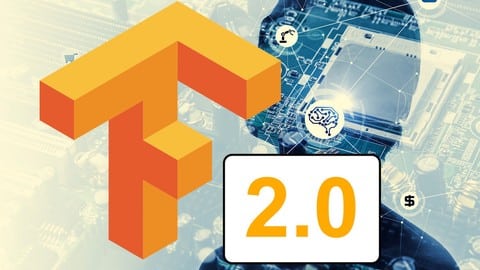Tensorflow 2.0: Deep Learning and Artificial Intelligence

Neural Networks for Computer Vision, Time Series Forecasting, NLP, GANs, Reinforcement Learning, and More!
- Artificial Neural Networks (ANNs) / Deep Neural Networks (DNNs)
- Predict Stock Returns
- Time Series Forecasting
- Computer Vision
- How to build a Deep Reinforcement Learning Stock Trading Bot
- GANs (Generative Adversarial Networks)
- Recommender Systems
- Image Recognition
- Convolutional Neural Networks (CNNs)
- Recurrent Neural Networks (RNNs)
- Use Tensorflow Serving to serve your model using a RESTful API
- Use Tensorflow Lite to export your model for mobile (Android, iOS) and embedded devices
- Use Tensorflow’s Distribution Strategies to parallelize learning
- Low-level Tensorflow, gradient tape, and how to build your own custom models
- Natural Language Processing (NLP) with Deep Learning
- Demonstrate Moore’s Law using Code
- Transfer Learning to create state-of-the-art image classifiers
- VIP Content: Build your own DeepDream Model
- VIP Content: Build your own Object Localization Model
- Know how to code in Python and Numpy
- For the theoretical parts, understand derivatives and probability
Description
Welcome to Tensorflow 2.0!
What an exciting time. It’s been nearly 4 years since Tensorflow was released, and the library has evolved to its official second version.
Tensorflow is Google’s library for deep learning and artificial intelligence.
Deep Learning has been responsible for some amazing achievements recently, such as:
- Generating beautiful, photo-realistic images of people and things that never existed (GANs)
- Beating world champions in the strategy game Go, and complex video games like CS:GO and Dota 2 (Deep Reinforcement Learning)
- Self-driving cars (Computer Vision)
- Speech recognition (e.g. Siri) and machine translation (Natural Language Processing)
- Even creating videos of people doing and saying things they never did (DeepFakes – a potentially nefarious application of deep learning)
Tensorflow is the world’s most popular library for deep learning, and it’s built by Google, whose parent Alphabet recently became the most cash-rich company in the world (just a few days before I wrote this). It is the library of choice for many companies doing AI and machine learning.
In other words, if you want to do deep learning, you gotta know Tensorflow.
This course is for beginner-level students all the way up to expert-level students. How can this be?
If you’ve just taken my free Numpy prerequisite, then you know everything you need to jump right in. We will start with some very basic machine learning models and advance to state of the art concepts.
Along the way, you will learn about all of the major deep learning architectures, such as Deep Neural Networks, Convolutional Neural Networks (image processing), and Recurrent Neural Networks (sequence data).
Current projects include:
- Natural Language Processing (NLP)
- Recommender Systems
- Transfer Learning for Computer Vision
- Generative Adversarial Networks (GANs)
- Deep Reinforcement Learning Stock Trading Bot
Even if you’ve taken all of my previous courses already, you will still learn about how to convert your previous code so that it uses Tensorflow 2.0, and there are all-new and never-before-seen projects in this course such as time series forecasting and how to do stock predictions.
This course is designed for students who want to learn fast, but there are also “in-depth” sections in case you want to dig a little deeper into the theory (like what is a loss function, and what are the different types of gradient descent approaches).
Advanced Tensorflow topics include:
- Deploying a model with Tensorflow Serving (Tensorflow in the cloud)
- Deploying a model with Tensorflow Lite (mobile and embedded applications)
- Distributed Tensorflow training with Distribution Strategies
- Writing your own custom Tensorflow model
- Converting Tensorflow 1.x code to Tensorflow 2.0
- Constants, Variables, and Tensors
- Eager execution
- Gradient tape
Temporary VIP Section (join NOW and get it before it’s gone!):
- DeepDream (3 exercises)
- Object Localization (7 exercises)
Instructor’s Note: Since Tensorflow 2.0 is still in beta, some features are not yet finalized. Stay tuned! 😉
Instructor’s Note 2: This course focuses on breadth rather than depth, with less theory in favor of building more cool stuff. If you are looking for a more theory-dense course, this is not it. Generally, for each of these topics (recommender systems, natural language processing, reinforcement learning, computer vision, GANs, etc.) I already have courses singularly focused on those topics.
Thanks for reading, and I’ll see you in class!
- Beginners to advanced students who want to learn about deep learning and AI in Tensorflow 2.0
Created by Lazy Programmer Team, Lazy Programmer Inc.
Last updated 11/2022
English
English [Auto-generated]
Size: 6.83 GB
https://www.udemy.com/course/deep-learning-tensorflow-2/

Again, Lisavr links are not working bro. Please help